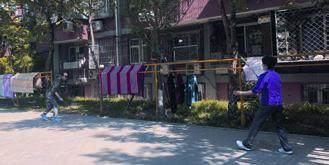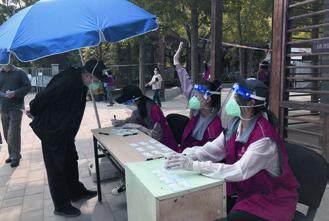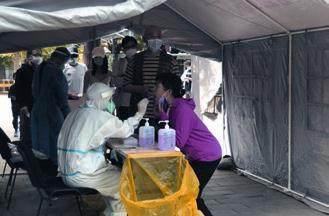Stay Positive,Test Negative
2022-05-29ByLiNan
By Li Nan
It’s May 18. My community in east downtown Beijing is buzzing, livelier than ever before. It’s the first day after a 23-day lockdown of the community was lifted. Residents with a temporary pass now can exit and enter the community freely. I volunteered to make and deliver temporary passes for residents. When I handed the tiny cards to them, I could see the excitement sparkling in their eyes.
Since March, clusters of infection by the Omicron variant have been emerging in Beijing. For this reason, the municipal government created three models of management to be applied to the city’s neighborhoods respectively marked as closed, controlled and prevention areas. On April 25, my community became a controlled area because several people visiting a nearby snack bar were confirmed to be infected, which resulted in lots of close contacts and secondary contacts in the area.

My husband was one of those close contacts, making other members of my family secondary contacts. For the first two weeks, my family was cooped up indoors, and served by volunteers; last week, I registered as a volunteer to serve my fellow residents after my home quarantine was lifted. The two different capacities gave me totally different experiences.
When I was under home quarantine, I was confined to our 53-square-meter apartment, with my mother-in-law, husband and daughter living under the same roof. It was crowded. When my daughter was having online lessons or my husband was attend- ing online meetings, my mother-in-law and I had to stay quiet in the corner.
After they finished, we would take turns to play table tennis or “take a walk” in the living room to get some exercise. I love jogging. Four hundred and forty-five round trips from the northwest corner to the southeast corner of the living room was little more than a warmup for me.
May 8 was the first day after our home quarantine was lifted. We were allowed to move freely within the residential compound but not out of it yet because the community lockdown had not been lifted. My family, like long-caged birds, flew out of our apartment in the early morning. My mother-in-law played badminton with her old friends and my eightyear-old daughter played house with her little confidantes in the courtyard.
I made a thorough tour of the compound, setting foot in every corner and on every path. I had never been so enthusiastic about my living environment. I found that so many enthusiastic gardeners in our neighborhood are growing Chinese roses, tulips and honeysuckles on their balconies.
Four days later, I realized that although the home quarantine was lifted for my family, Omicron was still spreading in Beijing and other parts of the world. The Democratic People’s Republic of Korea officially confirmed its first COVID-19 outbreak in May.
Among the 3,605 households in my community, 40 percent of residents are seniors, and many need regular medical attention. My 67-year-old mother-in-law is one of them. She has suffered from high blood pressure for years. She needs to take medication every day to keep her blood pressure stable.
There is a community-level hospital in our residential compound. It remained open during the community’s entire lockdown period. On May 12, four days after our home quarantine was lifted, my mother-in-law went to see the doctor in the tiny hospital and got her medication within 30 minutes. “It was as convenient as usual,” she told me.
The residents’ committee stepped in to help those who need medications unavailable at the community-level hospital. I was one of them. I was asked to put my medical insurance card, cash and a list of the medications I needed into an envelope. I gave it to the residents’ committee on the morning of May 13 and the medications arrived that evening, delivered by a volunteer. It was quite efficient.
Residents who have serious illnesses such as heart disease could apply for a pass to visit big hospitals in their own vehicles. Letters of commitment were required to ensure that they would only move between the community and the hospital. If anyone had symptoms similar to those of COVID-19 infection, such as fever, cough or headache, she or he was required to call an ambulance to go to the hospital to minimize the possibility of transmission.

Volunteers played a key role in ensuring my life was as normal as possible during my home quarantine. When we were not allowed to go outdoors, they helped deliver groceries and other necessities to our doorstep. To be part of them and share their workload was my way to say thank you.
I became a volunteer with the residents’committee on May 11 and worked for two to three hours per day. My duties included distributing COVID-19 antigen home test kits, collecting letters of commitment, making temporary passes, ensuring proper distance between residents lining up for nucleic acid tests and answering their questions.
Volunteering was a good way to get to know my neighbors. I moved to this community nine months ago. I knew few people and had no friend in the compound. By serving in the neighborhood, I made friends with other volunteers, including two doctors and some retirees. This made me feel more at home. Friendship, I think, is the biggest gift I received during this period.
During our community lockdown, I kept a close eye on the COVID-19 situation in the country. On April 25, the first day of the lockdown, China registered 1,908 domestically transmitted COVID-19 confirmed cases and 15,816 asymptomatic infectors. Thanks to the country’s dynamic zero-COVID approach and targeted pandemic prevention and control measures, those numbers were slashed to 227 and 1,000 respectively on May 17, the last day of the community lockdown. That’s a significant decrease.
The pandemic situation in China is getting better, but challenges remain and new clusters are emerging in other parts of the country. Let’s stay positive and test negative! BR

